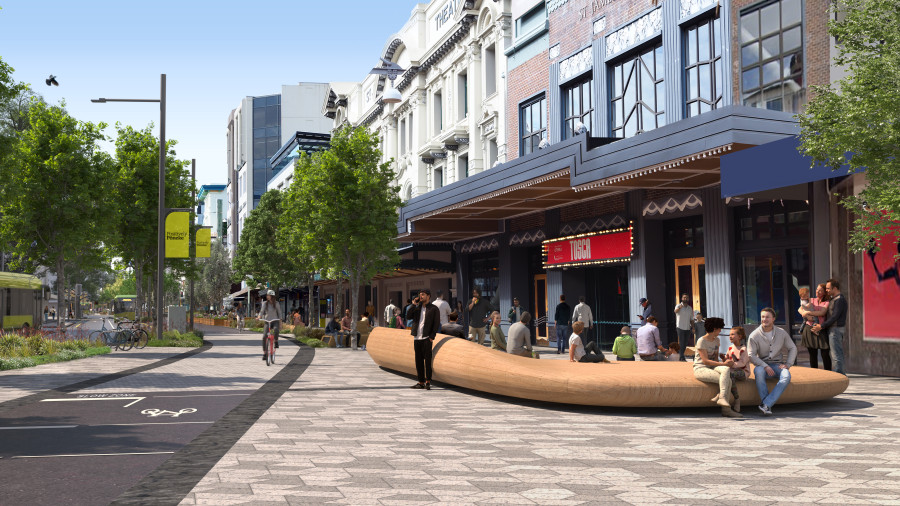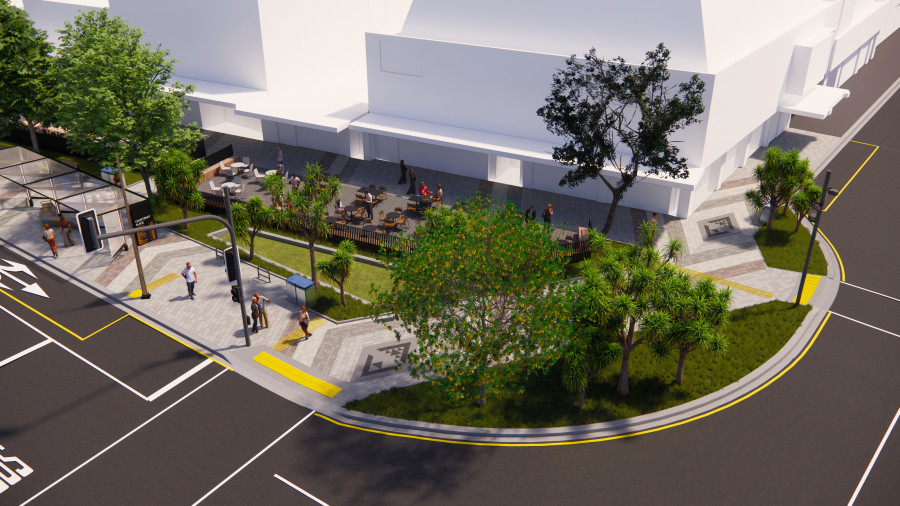Mana whenua designs and the cultural narrative

Artist's impression of the ūranga that will be placed outside St James Theatre
Our Tākai Here partners, Taranaki Whānui ki Te Upoko o te Ika / Port Nicholson Block Settlement Trust, Te Rūnanganui o Te Āti Awa ki te Upoko o Te Ika a Māui and Te Rūnanga O Toa Rangatira have been engaged in this project at both a governance and an operational design level and we thank them for their guidance and advice. The Tenths Trust have also provided advice and input.
An ūranga will have pride of place on Courtenay Place
In Courtenay Place, an ūranga (landing place) will have pride of place near the entrance to the St James Theatre. Ngā ūranga are natural resting places to pause and step out of the hustle and bustle of pedestrian flow and take a moment to connect and interact with each other. Traditionally places to land waka, ngā ūranga have been designed to indicate areas of cultural importance. They make the contemporary streetscape more welcoming to people, offering warmth, rest, light and solidity.
The ūranga on Courtenay Place is designed to be enveloping, supportive and to provide manaakitanga to passersby. It represents the narratives of the Tūpua (phenomena) Ngāke and Whātaiatai, both agents of seismic activity, who created the current form of Te Whanganui-a-Tara (Wellington harbour and the surrounding landscape). The patterns carved on the ūranga emulate the flow of water which connects the surrounding water tributaries that have cultural significance to mana whenua.
The highly textured paving surrounding the ūranga also emulates the flow of water and the ripples around this action. The pathway of Tūpua Hororangi, the evolving mass of fluidity, along the western edge of the harbour has created the land the city is now built on.
New pavement designs will connect us with our natural environment

Artist's impression of the pātiki on the eastern end of Courtenay Place
Patterns in the paving represent awa (waterways) and denote the location of the awa’s original meeting point with the pre-1855 earthquake and pre-reclamation shoreline. This Aramoana pattern occurs on the sites of awa crossings along Courtenay Place. The pattern grows in strength as it gets closer to another awa.
This pattern is described as koke (to move on a course) which travels along the length of the street, denoting movement, drawing attention to the place and the direction of the streams as they still flow through the landscape. Within this pattern, the pātiki (woven panel) central diamond-shape marks the more specific location of each awa as it now flows underground, to the current harbour edge. In the centre of the pātiki will be the name of each awa.
The pātiki form denotes the flounder, a fish that inhabits both fresh and salt water, like where the streams meet the sea. Within the pātiki shape is also the Niho Taniwha pattern, which uses interlocking teeth to symbolise whānau (family) and the interconnectedness of familial relationships. This paving design also reveals the strata, the earthy colours of Papatūānuku (earth mother), and evokes water with reflective ripples or waterlines in the paving.
In the cultural narrative of “Whārikitia te whenua”, the awa are seen as the hono, or hiki (stitches) that bind the whāriki (mats), laid over the landscape as a gift from Whātaitai. Awa are the pathways of water through the landscape of the city, and the awa on Courtenay Place connect these areas and the people that lived and live there.